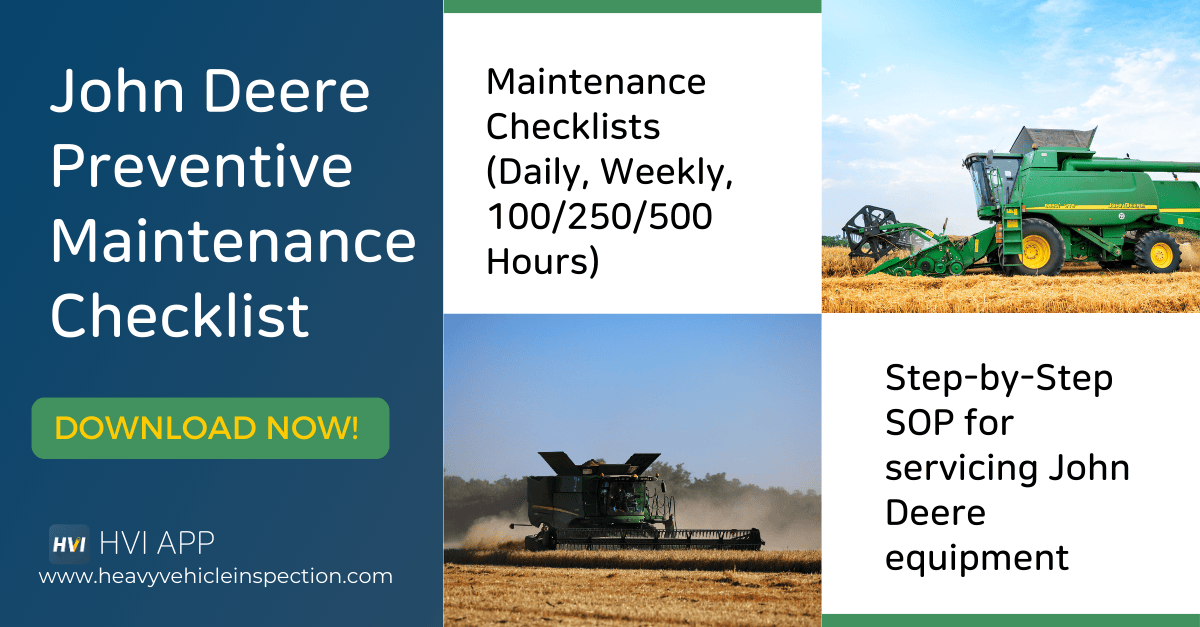1. Daily Maintenance Checklist
- Inspect for visible damage, leaks, or wear on the machine.
- Check fluid levels (engine oil, coolant, hydraulic oil).
- Test all lights, gauges, and alarms for functionality.
- Clean or replace air intake screens to prevent blockages.
- Grease pivot points, and moving components.
- Ensure tires or tracks are in good condition, and properly inflated.
Daily Inspection Breakdown
Detailed checklist for damage, leaks, and wear inspection:
Visible Damage
Fluid Leaks
Component Wear
2. Weekly Maintenance Checklist
- Perform all daily maintenance tasks.
- Inspect and clean air filters; replace if necessary.
- Verify proper tension on belts and tracks.
- Check the condition of the battery, and clean terminals.
- Inspect hydraulic hoses and fittings for signs of wear or leaks.
- Test parking brake and other safety mechanisms.
2A. 50 Hours Maintenance Checklist
For high-use equipment in demanding conditions:
- ✓ Clean engine cooling fins and radiator
- ✓ Inspect exhaust system for leaks
- ✓ Check hydraulic fluid condition
- ✓ Examine tires/tracks for wear patterns
- ✓ Test all control levers for smooth operation
- ✓ Grease PTO shaft and check shielding (tractors)
3. 100 Hours Maintenance Checklist
- Replace engine oil and oil filter.
- Inspect and clean radiator fins and cooling systems.
- Test alternator and starter motor functionality.
- Check and tighten bolts on critical components.
- Lubricate all grease points (pivot pins, axles, etc.).
- Inspect steering and braking systems for proper operation.
100-Hour Service Details
Critical systems to service at 100-hour intervals:
Engine Service
Cooling System
Lubrication
4. 250 Hours Maintenance Checklist
- Perform all 100-hour maintenance tasks.
- Replace fuel filters and clean the fuel tank cap vent.
- Check and adjust the valve clearance (if applicable).
- Inspect and replace hydraulic oil filters.
- Test hydraulic system pressure.
- Inspect wheel bearings or track rollers for wear and damage.
5. 500 Hours Maintenance Checklist
- Perform all 250-hour maintenance tasks.
- Replace transmission oil and filter.
- Flush and replace coolant as per manufacturer guidelines.
- Inspect final drive oil levels and replace if needed.
- Check for structural wear or cracks on key components.
- Test the entire electrical system, including wiring, connections, and lights.
6. Seasonal Maintenance Checklist
Spring Startup
- ✓ Replace air filters after storage
- ✓ Test battery and charging system
- ✓ Check all fluid levels and quality
- ✓ Inspect tires for winter damage
- ✓ Grease all fittings thoroughly
❄️ Winter Storage
- ✓ Change engine oil before storage
- ✓ Fill fuel tank and add stabilizer
- ✓ Remove battery and store indoors
- ✓ Clean machine completely
- ✓ Cover with breathable material
Standard Operating Procedure (SOP)
Preparation
- Gather all necessary tools, replacement parts, and fluids.
- Park the equipment on a flat surface and turn off the engine.
- Ensure the equipment cools down before starting any service.
Inspection
- Conduct a visual inspection of the machine, looking for leaks, wear, or damage.
- Check fluid levels, belts, hoses, and tracks for abnormalities.
Servicing
- Drain and replace fluids (engine oil, hydraulic oil, coolant).
- Replace filters and inspect related components.
- Grease all points and check for proper lubrication.
Testing
- Start the machine and listen for unusual noises or vibrations.
- Test all control systems, brakes, and safety mechanisms.
Documentation
- Record all completed maintenance tasks and observations.
- Update maintenance logs in the HVI App for tracking and compliance.
Take Action
Download our FREE John Deere Preventive Maintenance Checklist and start implementing smarter, more efficient maintenance processes. Experience the power of HVI App to enhance your equipment's safety and efficiency.
Common Warning Signs - Service Immediately
Stop operation if you notice:
- Blue Smoke: Engine burning oil - check levels immediately
- Black Smoke: Fuel system issues - clean/replace filters
- Overheating: Clean radiator, check coolant level
- Sluggish Hydraulics: Low fluid or clogged filter
- Hard Starting: Battery, fuel quality, or air filter problem
John Deere Fluid Quick Reference
Use the RIGHT fluids to protect your warranty:
- Engine Oil: John Deere Plus-50 II or API CK-4 rated
- Hydraulic Oil: John Deere Hy-Gard (JDM J20C spec)
- Coolant: John Deere Cool-Gard II
- DEF: ISO 22241 compliant only
- Grease: John Deere Multi-Purpose SD Polyurea
⚠️ Warning: Wrong fluids void warranty - Always verify in your operator's manual!
Frequently Asked Questions (FAQs)
1. Why is John Deere Preventive Maintenance important?
Preventive maintenance reduces unplanned downtime, increases equipment lifespan, and ensures peak performance during critical operations.
2. What fluids should be checked or replaced regularly?
Engine oil, coolant, hydraulic oil, and transmission oil are key fluids to monitor and replace during regular maintenance.
3. How often should I perform maintenance on my John Deere equipment?
Daily inspections, 100-hour, 250-hour, and 500-hour intervals are common benchmarks. Always consult your owner's manual for specific intervals.
4. Can I use the HVI App for John Deere maintenance?
Yes! The HVI App provides automated maintenance reminders, tracks service history, and integrates with real-time machine data for proactive service management. Schedule a demo to see HVI App features
5. What tools do I need for John Deere maintenance?
Standard tools include oil wrenches, grease guns, diagnostic equipment, and manufacturer-recommended filters and fluids.
Standardize John Deere Maintenance. Reduce Downtime.
Automate 100/250/500-hour services with digital checklists, reminders, and service history—keep your Deere equipment reliable and job-ready.








